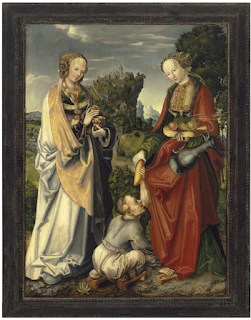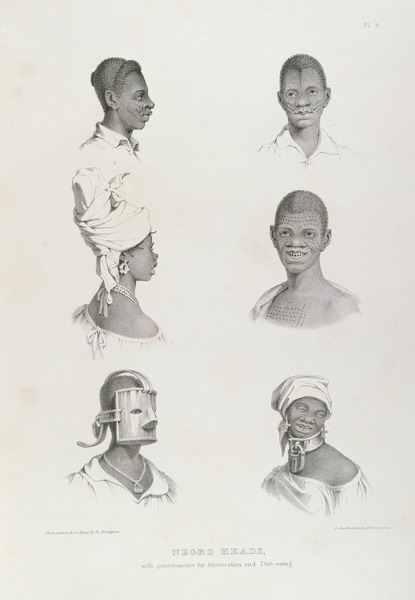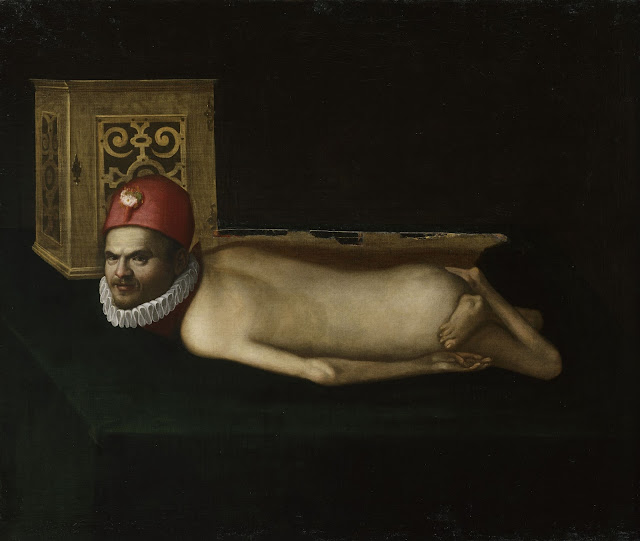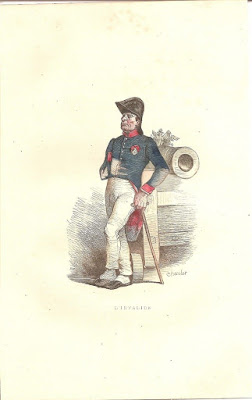Making of an accessible exhibition on Disability History. Experiences from LeibEigenschaften. Der „beschädigte“ Körper im Blick der Vormoderne [The pre-modern view on the ”impaired” body]
By Sonja Kinzler (curator)
Although calls for accessibility aren’t new, still relatively few curators are devoted to accessible shows. The exhibition LeibEigenschaften1 was part of the the DFG-funded research project "Homo debilis" at the Bremen University History Department. The 100 square meter exhibition was on display in the Bremen House of Science in March and April 2012. LeibEigenschaften aimed at a high level of accessibility and succeeded thanks to the interest among the involved parties to create something beyond the traditional modes of communication in museum displays, creating a choice of channels to receive the contents (vision, sound, touch; accommodation of cognitive and mobility restrictions). That the topic itself was Disability History was an important motivation for the team behind the exhibition.
Cordula Nolte, Professor in Medieval History at Bremen University, realized this potential early on and actively sought cooperation with local disability activists, a curator (myself), exhibition designers (ZwoAcht), and students from Bremen University and Bremen University of Arts. This concentrated competence made it possible to realize the project even on a limited budget. The exhibition was made to fit the House of Science. There was a great interest, however, in adapting it as an accessible, traveling exhibition, but those plans had to be cancelled due to lack of funding.
Purpose of LeibEigenschaften was to present living conditions and coping strategies of physically (and mentally) conspicuous people in the pre-modern period. The conceptualizing process started with us finding an agreement on what we considered to be the most important characteristics of the period in general, and deciding against a chronological presentation. We put emphasis on countering popular misconceptions about the way embodied difference was dealt with at the time: No, suffering wasn’t generally seen as divine punishment, and "disabled" persons weren’t necessarily abused and ostracized. We decided to do this without repeating and correcting the misconceptions but instead presenting and illustrating state-of-the-art interpretations of the topic. We also decided not to make explicit connections to the present, which allowed the visitor to experience a distant (in time, not space) culture populated by "cripples" and "raving maniacs", but without a trace of modern medical and social interpretations. Any connection to own experiences and similarities to the present were left to the visitor. This is why, also, the concept "disability" did not play a part in the exhibition, except for a brief introduction where we explained that the exhibition does without that term. However, in the texts in simple German we provided, the term was used, as we were unable to agree on another designation that was easily understandable. As mentioned, the exhibition wasn’t chronologically structured, but we needed to structure it somehow to make it comprehensible.
We immediately decided against arranging it according to types of "disability", not only because this would go against the perspective outlined above, but also since this kind of categorizations doesn’t fit the sources we presented. Instead, we used the topics "Mobility and Activity", "Care and Aid", "Back-Breaking Work – Illness and Health", "Miracle Cures and Miraculous Bodies", and "Admiring – Beholding – Concealing – Looking Away". This followed the structure of the "Homo debilis" project.
These themes were well suited to be translated to symbolic spaces that were important for pre-modern lifeworlds, especially relating to embodied difference: the bed, the street, the shrine, and the cabinet of wonders.
The exhibition designers were able to partially recreate a shrine and a cabinet of wonders on site. In the shrine, the visitors were confronted with the great significance of religion in the pre-modern worldview, and in the cabinet of wonders, the gaze on the conspicuous body and reactions towards "different" people were highlighted. The "bed"-section dealt with caring and nursing. The largest section was "the street", where the public sphere, labour, and physical aids were addressed.
Although the exhibition couldn’t go on the road, it did result in a number of publications that makes the contents and concept available to a wider audience. It was important to us to collect our experiences and make not only the contents, but the practical know-how we accumulated publicly available. We did this in the volume "Wissenschaft für Alle – in Ausstellungen barrierefrei präsentieren" [Science for all – How to make accessible exhibitions, edited by Cordula Nolte and Sonja Kinzler, Kiel 2012], a making-of story and a handbook for accessible exhibitions. It details the whole process working with LeibEigenschaften, from planning to the end evaluation. The book includes viewpoints from several experts, giving their perspectives on different aspects of accessibility: mobility, hearing, vision, and comprehension. They offered many insights that are hopefully valuable for future accessible shows.
Through this project came the realization that creating an accessible exhibition lets you learn a lot about curating. It trains you in opening different ways to access the contents. Curators should be aware of this from early on in the process and communicate it to the funding institutions: creating accessible exhibitions doesn’t mean spending a lot of money on a small minority of visitors. While making exhibitions available to everyone is important and in the end a question of democracy, dismantling barriers benefits everyone.
For further reading, see also:
www.leibeigenschaften.de
References:
Sonja Kinzler (2016): Making of an accessible exhibition on Disability History. In: Public Disability History 1 (2016) 13.
1 The title is a play with the German word for serfdom, „Leibeigenschaft“, which can be divided in „Leib“, body, and „Eigenschaft“, property in the sense of characteristic.↩
Although calls for accessibility aren’t new, still relatively few curators are devoted to accessible shows. The exhibition LeibEigenschaften1 was part of the the DFG-funded research project "Homo debilis" at the Bremen University History Department. The 100 square meter exhibition was on display in the Bremen House of Science in March and April 2012. LeibEigenschaften aimed at a high level of accessibility and succeeded thanks to the interest among the involved parties to create something beyond the traditional modes of communication in museum displays, creating a choice of channels to receive the contents (vision, sound, touch; accommodation of cognitive and mobility restrictions). That the topic itself was Disability History was an important motivation for the team behind the exhibition.
Cordula Nolte, Professor in Medieval History at Bremen University, realized this potential early on and actively sought cooperation with local disability activists, a curator (myself), exhibition designers (ZwoAcht), and students from Bremen University and Bremen University of Arts. This concentrated competence made it possible to realize the project even on a limited budget. The exhibition was made to fit the House of Science. There was a great interest, however, in adapting it as an accessible, traveling exhibition, but those plans had to be cancelled due to lack of funding.
 |
| Lucas Cranach the Elder: “Jüngstes Gericht, heilige Elisabeth und heilige Magdalena”, 1519. Collection of the Veste Coburg. |
We immediately decided against arranging it according to types of "disability", not only because this would go against the perspective outlined above, but also since this kind of categorizations doesn’t fit the sources we presented. Instead, we used the topics "Mobility and Activity", "Care and Aid", "Back-Breaking Work – Illness and Health", "Miracle Cures and Miraculous Bodies", and "Admiring – Beholding – Concealing – Looking Away". This followed the structure of the "Homo debilis" project.
These themes were well suited to be translated to symbolic spaces that were important for pre-modern lifeworlds, especially relating to embodied difference: the bed, the street, the shrine, and the cabinet of wonders.
The exhibition designers were able to partially recreate a shrine and a cabinet of wonders on site. In the shrine, the visitors were confronted with the great significance of religion in the pre-modern worldview, and in the cabinet of wonders, the gaze on the conspicuous body and reactions towards "different" people were highlighted. The "bed"-section dealt with caring and nursing. The largest section was "the street", where the public sphere, labour, and physical aids were addressed.
Although the exhibition couldn’t go on the road, it did result in a number of publications that makes the contents and concept available to a wider audience. It was important to us to collect our experiences and make not only the contents, but the practical know-how we accumulated publicly available. We did this in the volume "Wissenschaft für Alle – in Ausstellungen barrierefrei präsentieren" [Science for all – How to make accessible exhibitions, edited by Cordula Nolte and Sonja Kinzler, Kiel 2012], a making-of story and a handbook for accessible exhibitions. It details the whole process working with LeibEigenschaften, from planning to the end evaluation. The book includes viewpoints from several experts, giving their perspectives on different aspects of accessibility: mobility, hearing, vision, and comprehension. They offered many insights that are hopefully valuable for future accessible shows.
Through this project came the realization that creating an accessible exhibition lets you learn a lot about curating. It trains you in opening different ways to access the contents. Curators should be aware of this from early on in the process and communicate it to the funding institutions: creating accessible exhibitions doesn’t mean spending a lot of money on a small minority of visitors. While making exhibitions available to everyone is important and in the end a question of democracy, dismantling barriers benefits everyone.
For further reading, see also:
www.leibeigenschaften.de
References:
- Cordula Nolte, Sonja Kinzler (Eds): LeibEigenschaften. Der „beschädigte“ Körper im Blick der Vormoderne, Bremen 2012
- Sonja Kinzler: ”Wissenschaftstransfer in eine barrierefreie Ausstellung. Anmerkungen zur inhaltlichen Konzeption der Ausstellung LeibEigenschaften - Der ‚beschädigte‘ Körper im Blick der Vormoderne”, in: Cordula Nolte (Ed.): Phänomene der „Behinderung“ im Alltag. Bausteine zu einer Disability History der Vormoderne, Korb: Dydimos 2013, 25-36
Sonja Kinzler (2016): Making of an accessible exhibition on Disability History. In: Public Disability History 1 (2016) 13.
1 The title is a play with the German word for serfdom, „Leibeigenschaft“, which can be divided in „Leib“, body, and „Eigenschaft“, property in the sense of characteristic.↩


